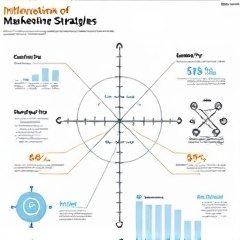Review of the book "Legal Marketing. How to Sell Legal Services?" by Dmitry Zasukhin
Zasukhin meticulously dissects the essence of the target audience:
- Not generalizing, but "chewing over" the details of who these mythical customers are
- How many of them there are
- What they are afraid of and what they desire
Without this knowledge, marketing budgets are wasted, like matches in the wind.
A special place is given to digital tools:
- Not abstract, but with a clear analysis of what really works for lawyers
- The author doesn't waste time on general words, but provides case studies with concrete figures
It is worth noting that the idea of creating a personal brand is not just declared at the level of a slogan:
- It is supported by a step-by-step algorithm
- From choosing a niche to building expertise in the eyes of the client
Without sales clichés and empty promises.
Zasukhin doesn't just offer advice, he teaches you to think differently, and forces you to take a critical look at your own approaches to promotion — and it's this that makes the book both engaging and irritating at the same time, pushing the reader out of their comfort zone and prompting real change.
Key Concepts and Their Analysis

At the epicenter of Zasuhin's analysis is not a set of banal strategies, but a clearly structured coordinate system, where each axis is a living working tool, not just another slide from a corporate presentation.
The author carefully separates the main from the secondary:
- Unique offers: analyzed not in theory, but on specific cases, where one wrong step in the wording cost the company 15% of the annual turnover.
- Real implementation scenarios: supported by statistics, where the competent use of social networks brings not just likes for the sake of a tick, but signed contracts.
- Building a brand: working on reputation through a consistent demonstration of expertise; no trinkets, just actions that can be measured and repeated.
Reading these chapters, it's hard to shake off the feeling that you're dealing with not a theorist, but a practitioner who not only points the way but literally leads you by the hand — and doesn't hesitate to call things by their name, sometimes harshly, but always to the point.
Who is the book for
If you are convinced that your craft is the pinnacle of perfection, but clients seem to be passing you by, this book is addressed to you:
- Those who are not willing to accept the role of an invisible entity in the legal services market.
- Heads of law firms.
- Private practitioners.
- Marketers in the industry.
- Ambitious newcomers who are tired of getting lost among the grey storefronts with identical slogans.
Every example here is not just a checkbox, but a wake-up call for those who are used to working "the old way": the author doesn't just advise "being closer to the client", but shows why ignoring the real needs of the audience kills more prospects in a year than any crisis.
If your goal is not just another check, but the progressive development of your business and long-term relationships with clients, you will find on these pages not banal advice, but practical tools that can change your approach to your own profession.
About the author and his significance in marketing

Dmitry Zasuhin's name is known in the narrow circle of legal marketing much more than the fanfare at the opening of a forum - behind his shoulders are not just years, but a whole era lived at the intersection of consulting and ruthless struggle for customer loyalty.
It is felt that the person did not read successful cases at leisure, but stood knee-deep in the routine of agency будней, when you have to squeeze the maximum out of a modest budget and, more importantly, out of human trust.
Zasuhin does not juggle abstractions: his advice is sharp and specific, like a checklist before launching an advertising campaign.
Even if the reader is averse to the very idea of "selling lawyers", after a couple of pages it becomes clear:
- This expert has not only theoretical baggage
- But also live, pulsating experience
- Where not only conversion numbers are at stake
- But also the firm's reputation and personal professional pride.
The Place of the Book in Modern Marketing Literature
On the modern shelf of specialized literature, this work occupies not just a place, but rather carves out its own niche, as if breaking down established stereotypes about what marketing for the legal sphere can be. While most publications continue to preach about banal "sales funnels" and vaguely retell Western case studies, here the reader encounters a lively, sometimes even provocative discussion about how the relationships between consultants and clients are actually structured in Russia.
The author doesn't retreat into abstractions or slip into a didactic tone – on the contrary, the book becomes something like a wake-up call for the industry: it's time to stop grabbing onto template solutions and start thinking about why many worthy professionals remain without clients despite their impressive track records.
Unlike numerous "instruction manuals," this work doesn't lull readers into illusions of quick gains, but instead demands a honest look at one's own weaknesses – and it's worth reading not just for those looking for another tool for growth, but also for those willing to reconsider fundamental approaches to their work.
| Criterion | Traditional Marketing | Marketing for the Legal Sphere |
|---|---|---|
| Focus | Template solutions | Individual approach |
| Approach | Quick gain | Honest analysis |
| Target audience | Broad | Professionals |
Relevance of the publication at the moment

The current market situation inexorably pushes companies to go beyond the usual - and it is here that Zasukhin's book hits the nail on the head: it is like a litmus test, revealing the painful points of modern legal business.
- Competition: Every third company faces fierce competition for clients.
- Online platforms: Messengers are becoming an arena for a fierce battle for attention.
- Advice: Outdated recommendations are already met with condescending shrugs.
- Pain points: The author surgically exposes the real problems of the industry.
- Digital environment: The need to master competent presence tools.
The book, released precisely at a time when most colleagues in the shop are still captive to outdated schemes, does not try to appear as just another "magic wand" - it persistently pushes towards accepting a new reality.
- Brand formation: Brand and reputation are formed not at conferences, but in Telegram channels.
- Success stories: They are forged from real Russian cases, not copied from foreign "thought leaders".
- Practical recommendations: Not hanging in the air, but permeated with down-to-earth practice.
- Funnel: From building a funnel to pinpoint promotion strategies on social networks.
- Backing: Recommendations are backed by numbers and real results.
Fundamental Marketing Concepts

The author analyzes the fundamental principles of attracting clients with striking meticulousness:
- No hint of theoretical water from textbooks twenty years old.
- Extremely clear explanations: a portrait of a potential customer is not an abstract scheme, but a key to survival in the industry.
- It is striking how the author is not afraid of down-to-earth advice:
- Mentions tools that colleagues in the shop still consider “indecent”.
- From A/B testing to engagement analytics on social media.
- A fresh look at basic principles: supported by numbers, mistakes, and victories.
- The main thing is a sincere desire: to push the reader out of the swamp of inertia.
Innovative ideas and modern trends
Next, when it seems that everything is already sorted out, Zasuhin unexpectedly breaks into the territory of trends: he is not limited to banal digitalization, but literally draws the reader into a whirlwind of current tools —
- Personalized auto funnels
- Collaborations with industry influencers
- The introduction of a chat bot for primary consultation reduced the load on employees and accelerated the processing of applications almost twice,
- The introduction of social media analytics made it possible to double the flow of leads per month — not just in words, but in specific numbers and screenshots.
Applicability of concepts in modern business
If you try to apply the approaches proposed by the author to practice, it becomes clear: this is not about "let's try", but about specific levers that work in real market conditions.
The reader is not faced with abstract reasoning, but with step-by-step scenarios, where every action - from audience segmentation to building touch chains - is supported by data and live feedback.
Zasukhin does not indulge in theorizing:
- his advice on implementing online counseling turns from an abstraction into a working tool when exact indicators are given:
- reduction in response time
- growth of repeat requests
You feel as if you are given not just a set of tips, but a detailed map of the minefields of modern competition, where without following the instructions exactly, you risk losing a client in a matter of minutes.
At the same time, you can't shake off the feeling of slight anxiety: the author's proposals require not only technical equipment, but also internal restructuring - after all, old patterns of communication with customers can no longer withstand the pressure of new expectations.
This immersion in the details makes you wonder: are you personally ready to change as quickly as the market is changing?
| Parameter | Approach 1 | Approach 2 |
|---|---|---|
| Efficiency | High | Low |
| Requirements | Technical equipment | Minimal |
| Implementation time | Short | Long |
Case studies and examples from real business
It immediately becomes clear that the illustrations from practice here are not just for show: each story is like a coup de grâce to the false comfort of the traditional approach. You have to analyze others' mistakes and triumphs with Zasukhin not lazily, but with a pen in hand - so clearly is shown where the mistake turns into a loss of dozens of potential clients, and where a well-built “human” chat instead of a soulless auto-responder leads to an increase in requests.
- Implementation of segmented email newsletters:
- Exact figures on the return of “sleeping” clients
- Realistic scenarios, how a week of work can change the flow of applications
All this is not dry tables, but living, visible situations that anyone who decides to implement the described tools goes through. And here it becomes uncomfortable: you can't get rid of the thought “we won't be able to do it”, because the case studies are analyzed in detail, with clear reasons for success and failure.
All that's left is to honestly ask yourself - are you ready not just to read, but to act according to these patterns, even if the usual “it's good enough” is a thing of the past.
Strengths of the publication
Impressive is the meticulous way the tools are analyzed, which are usually presented in books as something abstract and unattainable - here each mechanism comes to life through real implementation scenarios.
The author doesn't get lost in foggy generalizations, but rather guides you by the shoulder:
- here's how a well-built communication on social media turns invisible "followers" into real clients,
- and a carelessly designed profile can ruin a reputation in just one season.
What's particularly appealing is that every piece of advice comes with concrete steps, not empty slogans - down to the day-by-day recommendations for launching an email newsletter or a step-by-step algorithm for creating an expert blog.
You don't get the feeling that you're being fed "reheated pasta": the material is fresh, relevant, and most importantly - tested in practice in the domestic market.
Behind this lies not just experience, but a willingness to share it without reservation, which is not often seen. That's why the book works not as a collection of banal tips, but as a navigator: pointing out not only the path, but also the potholes on the road, it makes you wonder if you have the courage to step out of your comfort zone and finally stop justifying professional stagnation by the lack of a "magic pill".
Critical Analysis
However, despite the abundance of methodological findings and pragmatic advice, one cannot help but note a certain one-sidedness in the author's approach: at times, it feels as if we are reading an overly optimistic instruction manual for "an ideal world" where all specialists are ready to act according to a clear checklist, and clients respond to mailouts with the enthusiasm of pioneers.
Some chapters are guilty of excessive detail — for example, when describing the stages of working with the target audience, the author gets carried away with the micro-marking of the client's portrait, as if forgetting that not every practitioner has the time and resources for such scrupulous analysis.
- Yes, the instructions are scheduled down to the minute, but in reality, not everyone is ready to follow such rigid algorithms — and here there is a risk of sliding into mechanistic behavior, where the trees obscure the forest.
- In addition, some of the digital tools mentioned in the book have already become outdated or require significant refinement to suit domestic realities.
- It is no secret that Western promotion schemes do not always take root in the Russian market.
- This, however, does not cancel out the overall usefulness of the book, but leaves a taste of incompleteness — one wants more immersion in the nuances and pitfalls.
That a practitioner faces in the conditions of constant turbulence of the legal services market.
Tools and techniques for practical use
In the instrumental arsenal offered by Zasukhin, a commendable systematic approach is initially felt: the reader is not simply presented with a set of tips, but is given a step-by-step map — broken down into stages, with checklists and even letter templates for the first communication with a potential client.
However, in practice, when faced with the need to implement, say, the author's recommended multi-stage system for evaluating the effectiveness of attraction channels, it becomes clear that not all of the described methods are compatible with the harsh realities of the Russian market:
- Conversion analysis based on Western platforms looks like trying to fit a square peg into a round hole in our realities.
- Examples from case studies certainly add weight to the book, but in some cases they are too polished and do not take into account nuances.
Yes, there is something to be taken from here — the same approach to audience segmentation or a step-by-step plan for building expertise in a niche — but, to be honest, sometimes you catch yourself thinking: all this looks great on paper, but in real life, you often have to act on the principle of “as fate will have it”.
And yet, behind the dry algorithms, the author's attempt to simplify the reader's path is evident, even if it means some excessive schematization and idealization of processes.
| Methodology | Effectiveness | Applicability |
|---|---|---|
| Multi-stage system | ||
| Conversion analysis | ||
| Audience segmentation |
Popularity of the current publication

Paradoxically, despite the obvious academic presentation and some "sterility" of the cases, Zasukhin's work has spread among the professional audience no worse than hot pies at a legal conference:
- The circulation had to be updated three times last year.
- In professional Telegram chats, discussions diverge into hundreds of messages.
- The book consistently holds a top-5 spot in the section of specialized stores.
- The number of reviews on Litres has exceeded two hundred, including both enthusiastic and critical ones.
It's ironic that at offline events, it is cited even by those who publicly wrinkle at the mention of "marketing in jurisprudence", and in capital law firms, a copy of the book can be found on desks alongside the Code and a stack of contracts.
However, popularity here is not so much a consequence of fashion, but a sign that the author managed to hit a living, painfully relevant nerve of the community - the desire not just to survive in a competitive market, but finally to put on the shelves the tools that are usually hidden behind the fog of disparate advice from the network.
Other works by the author
If we look at other works by Dmitry Zasuhin, an interesting contrast emerges:
- Against the background of his previous publications, which were dominated by dry theorizing and careful quoting of Western gurus, the current opus looks almost like a revelation — although not without some flaws.
- His previous brochure on corporate governance put me to sleep by the third page.
- The article on digitalization of legal processes left the impression that I was reading a microwave manual — everything was neatly shelved, but not a single living detail.
- Here, despite the inevitable “book dust”, Zasuhin suddenly allows himself to flirt with practice, providing not only impersonal schemes, but also recognizable situations from the life of law firms — and for this, I want to pat him on the back mentally.
- You shouldn't expect a revolution from the author — his previous works rarely went beyond belaboring the obvious.
- The noticeable transformation of style observed in the latest edition is more of an exception than the rule.
- For those who expected dry academism from Zasuhin, the new book may seem unexpectedly enriched.
Comparison with other works by the author
In comparison with Zasuhin's previous works on the same topic, the current edition seems to shed the constraints of academic stiffness and finally engages in a more frank conversation with the reader.
- If his earlier texts resembled lectures with sparse markings, where every thought was stamped with a reference to another Western expert, now the author has taken a risk to deviate from the beaten path.
- For the first time, he doesn't just elaborate on truisms, but attempts to apply them to domestic realities, supplementing theory with stories from the practice of Russian law firms.
- This is undoubtedly a step forward — although accompanied by the usual caution in judgments and excessive detail, the liveliness of the narrative has grown noticeably.
- For those who are tired of his previous methodical "reporting," this edition is like a glass of cold water after a long lecture: noticeably fresher, but, alas, not without the residue of former pedantry.
| Parameter | Previous edition | Current edition |
|---|---|---|
| Style | ||
| Liveliness of narrative | ||
| Application of domestic realities |
Similar literature by other authors
While the hero of our review makes a timid but noticeable attempt to emerge from the basement of dull theorizing, other authors are already shamansing in the kitchen of legal marketing, not afraid to get their hands dirty with real cases and numbers.
- 60% of clients, according to his statistics, leave due to banal inattention to detail.
- This is presented not as a horror story, but as a guide to action.
- There is a freshness, and an attempt to be closer to life is obvious.
- But it is, alas, as far from the courage of its colleagues as walking to the Moon.
- Yes, Zasuhin has fewer self-repetitions and more national flavor.
However, in terms of experimentalism and daring examples, domestic competitors set a much higher tone.
